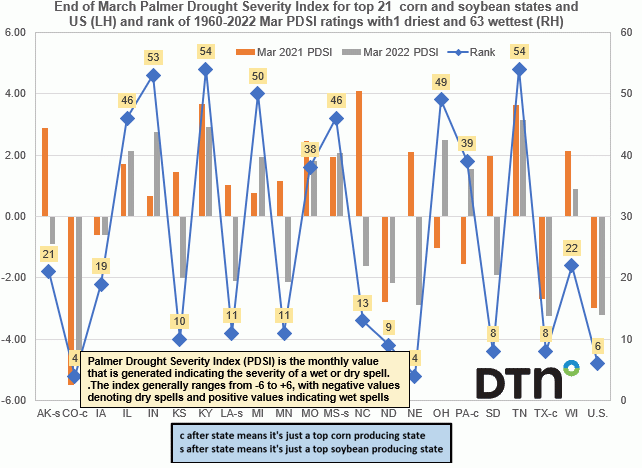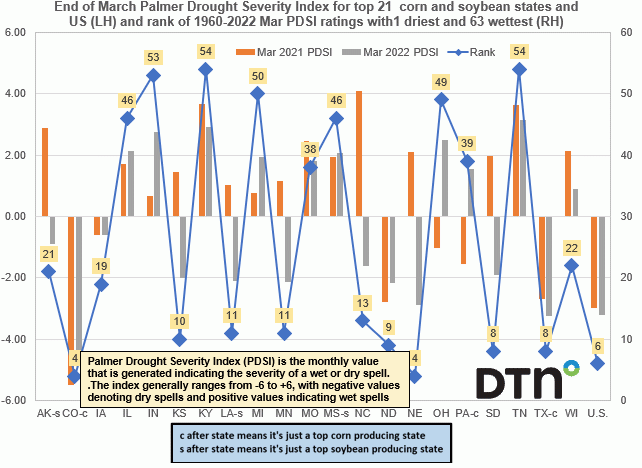Fundamentally Speaking
Moisture vs. Drought in Corn, Soybean States
Similar to what we recently did with winter wheat, this graphic shows the end of March Palmer Drought Severity Index (PDSI) for the top 21 corn and soybean producing states and the US on the left-hand axis while where the March 2022 PDSI reading ranks from the period 1960 to 2022 is plotted on the right-hand axis with 1 being the driest or most drought afflicted since 1960 and 63 being the wettest.
For reference, the Palmer Drought Severity Index (PDSI) is the monthly value that is generated to indicate the severity of a wet or dry spell.
The index generally ranges from -6 to +6, with negative values denoting dry spells and positive values indicating wet spells.
P[L1] D[0x0] M[300x250] OOP[F] ADUNIT[] T[]
PDSI values 0 to -0.5 =normal; -0.5 to -1.0 = incipient drought; -1.0 to -2.0 = mild drought; -2.0 to -3.0 = moderate drought; -3.0 to -4.0 = severe drought; and greater than - 4.0 = extreme drought while similar adjectives are attached to positive values of wet spells.
The chart reflects what has been the case for a while with the eastern half of the country far wetter than the western half where long standing drought conditions are pervasive.
Some takeaways include the fact that those states that were quite dry a year ago are still in the same boat led by Colorado, for even though their end of March 2022 PDSI rating at -4.82 is not as low as the March 2021 PDSI rating of -5.48, CO is still in extreme drought with the fourth driest conditions since 1960.
North Dakota also slightly improved but moderate to severe drought is still widespread in that state, especially in western areas, although maybe recent heavy snow has resulted in more improvement.
Drought in Texas has worsened over past 12 months with the U.S. seeing the lowest end of March PDSI ratings since 2013 when country was recovering from the horrific 2012 drought.
Then you have a number of states that had positive PDSI ratings last March but now a year later have negative readings, some significant, and they include KS, LA, MN, NC, NE, and SD.
It is only in the Eastern Corn Belt and mid-South where a number of states have seen decent subsoil moisture levels such as those in IL, IN, KY, MI, MS, OH, PA, and TN where PDSI readings above 3.00 are actually causing some planting delays.
(c) Copyright 2022 DTN, LLC. All rights reserved.






Comments
To comment, please Log In or Join our Community .